
In February in Palm Springs, young men’s fancies turn to love. Diamonds are involved.
With a lust for success and a romantic vision of their own abilities, 300 come from far and wide to live the most worthwhile of clichés. They are here for the California Winter League, a unique baseball creation that allows them to “chase their dream.” More than a few visualize themselves playing this month in a major league uniform on opening day in the big leagues.
Nobody ever said dreams have to be realistic.

Nothing less than blue skies are the order of the day, every day, for the California Winter League.
From mid-January to mid-February, with much of the rest of the Northern Hemisphere stuck in snowbanks, the sound of bat striking ball echoes across the venerable Palm Springs Stadium. Palm trees rustle in gentle wind. Snowcapped mountains glisten in the distance. If Ernie Banks were still with us, he would demand to play two.
It is all too fitting that this brainchild of Palm Springs businessman Andrew Starke, which begins with games on Jan. 21, ends with the championship game on Feb. 14. Valentine’s Day.

Being deaf has not stopped Jalen Harris from pursuing his major league baseball dreams.
One player, Jalen Harris, summarizes the infatuation perfectly: “I go to sleep thinking about baseball,” he says. “Then I wake up thinking about baseball. There is nothing wrong with that.”
Harris is 23. He is a slick-fielding shortstop from Toronto and has been on the doorstep of making it in the major leagues.
“I was cut in the final week of spring training with the [Milwaukee] Brewers last year,” he says, “when I was hitting .421.”
He is also deaf, something he says he sees as no impediment to his affair of the heart.

The CWL is Andrew Starke’s baby, and behind those sunglasses he misses nothing.
This is the seventh, and most successful, year of Starke’s creation. He is 36, a former college player from Florida, whose set-jaw approach to life and business may be best exemplified by a record he still holds in one of the leagues he played in years ago — most times hit by a pitch.
Once he got the backing of Palm Springs officials for use of the stadium, where the big-league Angels once held spring training before departing to Arizona, Starke started with 56 players in 2010. This year’s 300 measurably boosts the credibility of the league.
For one month, Palm Springs is right out of Bull Durham. There are no Kevin Costners, no Susan Sarandons, but plenty of 22-year-olds, scratching and spitting and talking about going from first to third. The clank of spikes is daily background music, and the outfield fences are filled with ads for local businesses.
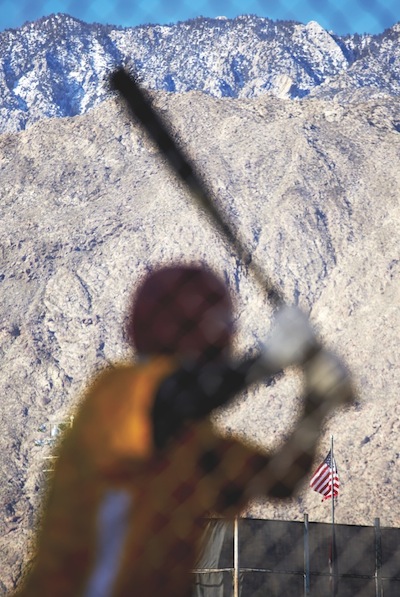
One player, used to snow in Chicago, said of the view on his first trip to the plate, “I had to step out for a moment.”
If you hit one well, you clear the Sherman’s Deli sign. If a team scores nine runs in a game, it’s free tacos for all the spectators. Who, in the beginning of the season, might number in the single digits.
The business model is interesting. Starke charges each player around $3,000 (some returnees get discounts), for which players are housed and fed (two meals a day), and given a spot on one of the 14 teams. That means Starke starts with roughly $900,000 and generates additional revenue from attendance and concessions. From that, he also needs to meet a payroll that includes several dozen coaches, plus a statistical crew, game announcers, and umpires.
Players are assigned teams by Starke and his staff, and each team plays 14 games, heading into a four-day championship playoff. Most of the players are 23 or 24 years old. Many are college graduates left undrafted and unencouraged by the major leagues. Most are veterans of dozens of one-day tryouts all over the country. That’s why Starke’s 28-day CWL is so different and so appealing.
“I call this spring training on steroids,” he says

From the league’s auxiliary field, the batter’s box offers a spectacular view of the San Jacinto Mountains.
The Lefty from Indy
It’s Tuesday, Jan. 26, and Garrett York is on the mound for the British Columbia Bombers. York is from New Castle, Indiana. He has never been to British Columbia. Nor, most likely, have any of his teammates.
Starke and his staff name the 14 teams randomly, but not without motive. Several carry Palm Springs area designations (the Chill, the Power, the Palm Desert Coyotes, Coachella Valley Snowbirds), and several more carry Canadian monikers (Manitoba North Stars, Canada A’s, BC Bombers). The goal is to give spectators, sparse as they may be until the playoffs, a local cheering interest — local being actually local or Canadian-snowbird local.
York is a left-handed pitcher. He graduated in June from Earlham College in Indiana, where he was a star pitcher on the school’s most successful NCAA-era team, which had a 26-14 record. York might as well be the poster boy for the CWL. Starke calls him “our generic player,” meaning a typical overachiever with borderline big-league skills.

Pitcher Nicholas Arnoni of the Palm Springs Power intensely monitors the action on the field.
“He is a situational left-hander,” Starke explains. “He throws in the low 80s [miles per hour] and would fit on a team that might have four or five right-handers, all bringing heat in the mid-90s. You send York out there to throw off their timing.”
In the second sentence of our conversation, York talks about “chasing his dream.” He is smart, a bit more realistic about his skills than some of the others, but not quite ready to quit on himself or that dream.
That is a recurring theme during the 28 days of baseball, so prevalent that one of the coaches, Dan DiPace, says he takes it upon himself to make sure the players modify their illusions of grandeur. Few would be better qualified than DiPace to do this. He once was a star prospect, so good that in the 1966 Carolina League, he batted .330, while a colleague named Rod Carew managed only .285. Carew is in the Hall of Fame. DiPace never got to the bigs.
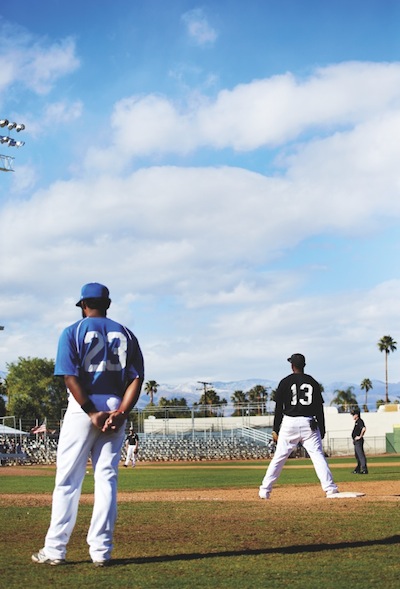
The CWL is serious business. No focus can wander, from the bench to the field.
“The first day,” says DiPace, “I gather them around and tell them that they have about as much chance of making it in the major leagues as they do becoming brain surgeons.” York is not throwing heat, but he is striking out batters with good control, a sinker that is tricky, and the kind of intelligent focus on what he is doing that is an intangible smart scouts will see. And even though the CWL is an unlikely MLB personnel resource, professional scouts are here, every day.
The day is an incredible testimonial to winter in a place where there really is none. It is 73 degrees by 11 a.m. The game is on an auxiliary field behind Palm Springs Stadium. It features artificial turf and a majestic view of the mountains from the batter’s box.
Quintin Alexander, a 24-year-old infielder from Chicago and Chicago State University, talks about his first trip to the plate at the auxiliary field. “I looked up,” he says, “and I had to step out of the batter’s box. I just came from snow and cold. That view was just too overwhelming.”

How do you adjust your fingers for a fastball, slider, curveball? Lefty Garrett York works the seams as he prepares to pitch.
In the stadium, where outfielders face the mountains, one fly ball settles to the turf in left centerfield. The player accused of muffing the catch tells his coach, “I lost the ball in the snow.”
Veteran fans arrive for a game on the auxiliary field with folding chairs and lunch in backpacks. They sit under or near a fat, old eucalyptus tree behind home plate. Finding shade in January is the order of the day, as disgusting as that might be for people back east. One woman has a chair equipped with a side bed for her little dog, who sleeps through bats hitting balls and umpires bellowing “strike three.” An elderly man, obviously a regular, sits in a beach chair in shorts and T-shirt, bare feet resting atop his flip-flops, and notes a runner on first base.
“Roll it up,” he yells to the team on the field, using the inside-baseball term for getting a double play.
There is no wind, unusual for Palm Springs. A candy wrapper placed on a table at 11 a.m. is still there at 4 p.m.
Thaddeus Kreus is a member of Starke’s media crew. It keeps statistics, compiles game programs, works the public address system, and does the play-by-play for Internet streaming of games. Staffers are paid very little, but this is Kreus’ second year.
“It’s about $230 every other week,” he reports, “but they put me up with the same nice lady this year. We don’t get home until late sometimes because of all the stats we do, but I got home last night and she had a great bowl of chili waiting for me.”
Kreus is a veteran from Florida. If you are here a second year, you have the right to become a weather local. He looks at the cloudless sky and says, “Yesterday, no clouds, either, but I think we saw a wisp.”
He chuckles as a home run clears the left field fence and clanks hard off the hood of a parked car. York is keeping his slider down and away and causing several foul balls to float onto Baristo Road. Cars approaching its stop sign are escaping dents by yards, sometimes feet. The veteran Kreus, with his back to Baristo, has seen the angle of so many foul balls that, without even turning around, he can do the play-by-play of impending vehicular thumps.

Garrett York ponders his big-league future.
“Possible,” he says of the trajectory of one on its way out . “Possible.”
Jeremy Del Gado is at shortstop for the team opposing York’s BC Bombers. He is from Long Island, New York. His parents, Roger and Millie, watch from the bleachers. Del Gado is in his second year of the CWL. His parents say he is a determined young man.
At one point, he slides into third base and, unaccustomed to the artificial turf, looks more like a dolphin than a baseball player. He yells and his coach quickly assures all, especially his parents, that he’s fine.
An inning later, with Mom and Dad about 10 feet away, Del Gado is batting and takes a pitch in the helmet. He goes down hard. He stays down for a minute or so, then gets up, trots to first base, and steals second on the first pitch.
York has a college degree in computer science. He used it working for a foam rubber company in Indiana in the fall, establishing programs for better work flow. Mostly, he was saving money so he could continue chasing his dream.
He has spent almost every minute of his post-graduation time doing exactly that. He sent out 50 letters to teams, major league affiliates, and independent league teams, especially independent teams in the Midwest, led by the Frontier League.
He got an offer from the Mount Rainier League in Washington, flew there from Indiana, got into one game, and pitched 2 2/3 innings. He was scheduled to pitch again when the league folded.
“We saw something on the Internet that they needed another $70,000 to keep playing,” York says. “I pretty much knew then, but we stayed around for a couple of days, just hoping. We paid for our own hotel rooms at the end.”
Welcome to subminor baseball.
York flew home and began an odyssey that took him from Ohio to St. Petersburg, Florida, to St. Louis to Indianapolis to Cleveland and to Santa Fe, New Mexico.
“By the end of that, my arm was garbage,” York says.
During the fall, he made a quick drive most days from work in New Castle to his college in Earlham to help coach the baseball team, and he never stopped thinking about chasing his dream. Then he got a note from Pete Wagoner, Starke’s league commissioner.
And here he is, on a Chamber of Commerce Tuesday in Palm Springs, still chasing.
“I figure,” York says, “that it can come down to the right guy, sitting in the stands at the right time. You just have to get somebody to like you.”
York strikes out the first two hitters he faces, then, when he gets into his first jam in a later inning, induces the perfect double-play ball. But the relay from the second baseman heads for Baristo Road.
Welcome to subminor baseball.

Coaches coach, players listen. One coach always tempers his players’ illusions of grandeur. Chances are slim any will move on to the majors.
Baseball Is for Lovers
Valentine’s Day brings a big bouquet of roses for Starke. The final game matches the Palm Springs Power against the Manitoba North Stars.
“What could be better than this,” he gushes. “You have sunshine in a great place and a baseball game to see.”
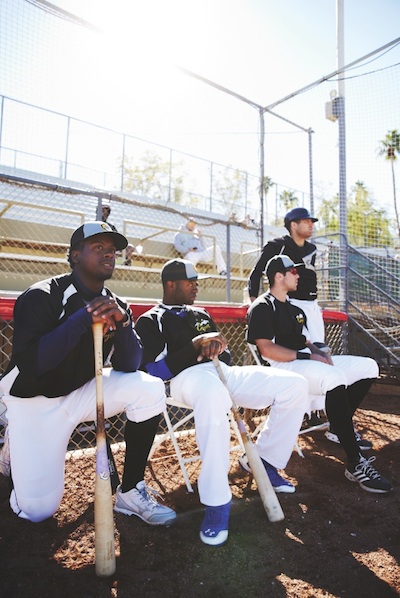
The boys of summer play winter ball in Palm Springs.
You also have his favorite-named team for the local fans (Starke’s Palm Springs Power plays as an entry in a summer collegiate league) and a Canadian team, the Manitoba North Stars, for the snowbirds, some of who seemed confused when they look at their team’s roster and see just one Canadian. No matter. A total of 712 people have claimed tickets, some comped, some paid.
Starke also can claim great success this season: Two of his players have signed on to major league spring training rosters.
The first, a 6-foot 6-inch lefty pitcher named Evan Crower, had been the backup to Stanford’s Kevin Hogan, this year’s Rose Bowl–winning quarterback. Crower was so impressive to scouts in the first day of workouts for the CWL that the Phillies plucked him off and scheduled him for their training camp in Clearwater, Florida. He didn’t play a day in Palm Springs. Nor did he get his three grand back.
“He got what he wanted,” Starke says.
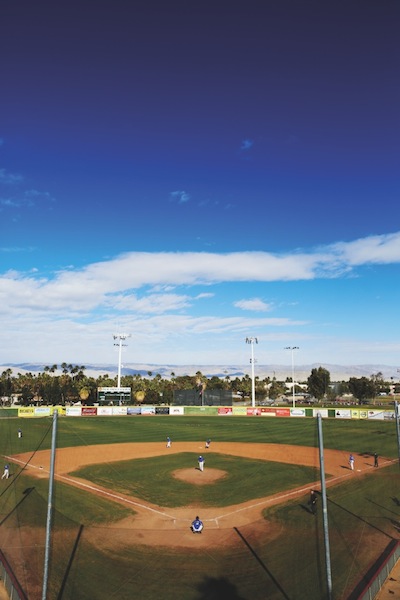
A typical day — soft clouds, warm temperatures.
Later in the camp, catcher Steven Pollakov of Chicago was taken by the White Sox and immediately headed for Arizona, where the team holds spring training.
Starke says that the closest his winter league program has come to producing a major leaguer was last year, when Troy Marks, a right-handed pitcher, made it to the Diamondbacks Triple-A team, but got cut after the season.
But clearly, the reputation and credibility of the CWL are on the rise.
For this title game, fans cluster in the shade, under the misters below the press box. It’s 92 degrees at noon. Several people chat, smugly noting that in New York, it’s 10 degrees with a wind-chill factor of zero.

Jalen Harris leaves the dugout, but never his dream.
Both the U.S. and the Canadian flags fly in center field. A stirring rendition of “Oh, Canada” booms from the loudspeakers. Eldon Schechtel of Edmonton, Alberta, who made the trip in from Desert Hot Springs, listens proudly and remarks, “The beer and hot dogs are great, too.”
The North Stars’ Buddy Elgin hits a homer that heads for Baristo, but the ball lands silently somewhere in the traffic. Manitoba is off and running to its eventual 6-2 victory. It’s wonderful baseball in a time when it usually isn’t played, but in a place where it can be. A fan drops a foul ball and gets booed. The Power center fielder makes a lunging catch and the batter’s called out. Suggestions are made from the stands that the ball was trapped; additional suggestions are made about killing the ump. When a player draws a walk, a well-prepared PA announcer pounces: “That batter has an eagle eye. Get your eagle eye at the Milauskas Eye Institute.”
A Manitoba player named Victor Barron crushes a home run to right field and York, a spectator now, shakes his head.
“That’s the same guy who hit one off me here the other day,” he says. “I hadn’t given one up since my junior year in college.”
After the sixth inning, Starke directs the announcers to inform the spectators that beer prices are lowered to $2. People rush to the concession line.
When Manitoba closes out the Power, the players gather on the mound, put on championship T-shirts, and are serenaded over the PA system with “We Are the Champions.” The fans cheer as they open Champagne and spray it all over each other. This is subminor ball, but the celebration is big league.
Starke says it’s possible that as many as 100 of the 300 players from this CWL season will get some sort of formal interest from independent leagues for the coming summer, and maybe as many as half a dozen will get a look from major league–affiliated teams.
York shakes hands and says goodbye. He says the month in Palm Springs has changed his life, has made his resolve to do this even more intense. Instead of going back home to Indiana, he’s driving to Seattle, where there’s a pitching school designed to improve velocity.
“The scouts say that when they are looking at right-handers, if they don’t throw in the 90s in their first four pitches, they are done with them. For left-handers, it is 86. I think I can get there.”
Ideally, as he heads to the Pacific Northwest, he’ll drive along the Pacific Coast Highway. Chasing your dream might as well be picturesque.
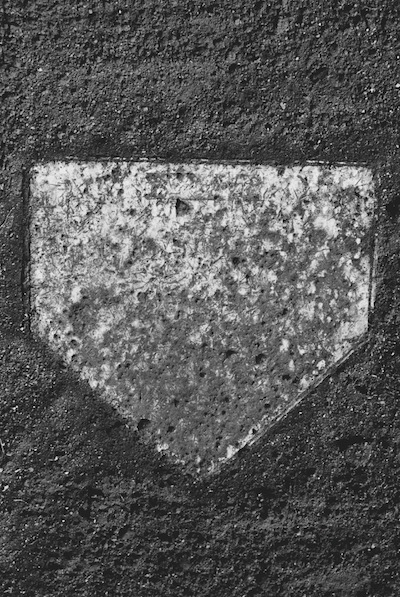
.
A Role Model for Dreaming Big
Before the first pitch is thrown in the championship game of the California Winter League, a 9-year-old girl named Lilly Neiser is handed a microphone. She boldly sings the impossibly difficult U.S. national anthem. In the Manitoba North Stars dugout, her father, Evan, swells with pride. When she finishes, to a rousing spectator reception, Evan takes the mound. He’s the starting pitcher.
After his team wins in convincing fashion, Neiser celebrates on the mound with his teammates, then stands off to the side with Lilly and her sisters, Ceci, 5, and Maggie, 1. He is the winning pitcher at a modest 5-foot-9 and 160 pounds. He is also 34, an unlikely age to still be out there, still chasing his dream.
Neiser is a nurse, lives in Grass Valley in Northern California, and says he would quit his job in a minute if he got the right chance in baseball.
“I’m realistic about age,” he says. “But if you can get people out, it doesn’t matter.”
He says that his wife, Celeste, is supportive of what others might perceive as a pipe dream. He says that she wants their daughters to see the importance of pursuing something in life that you really love.
— B.D.